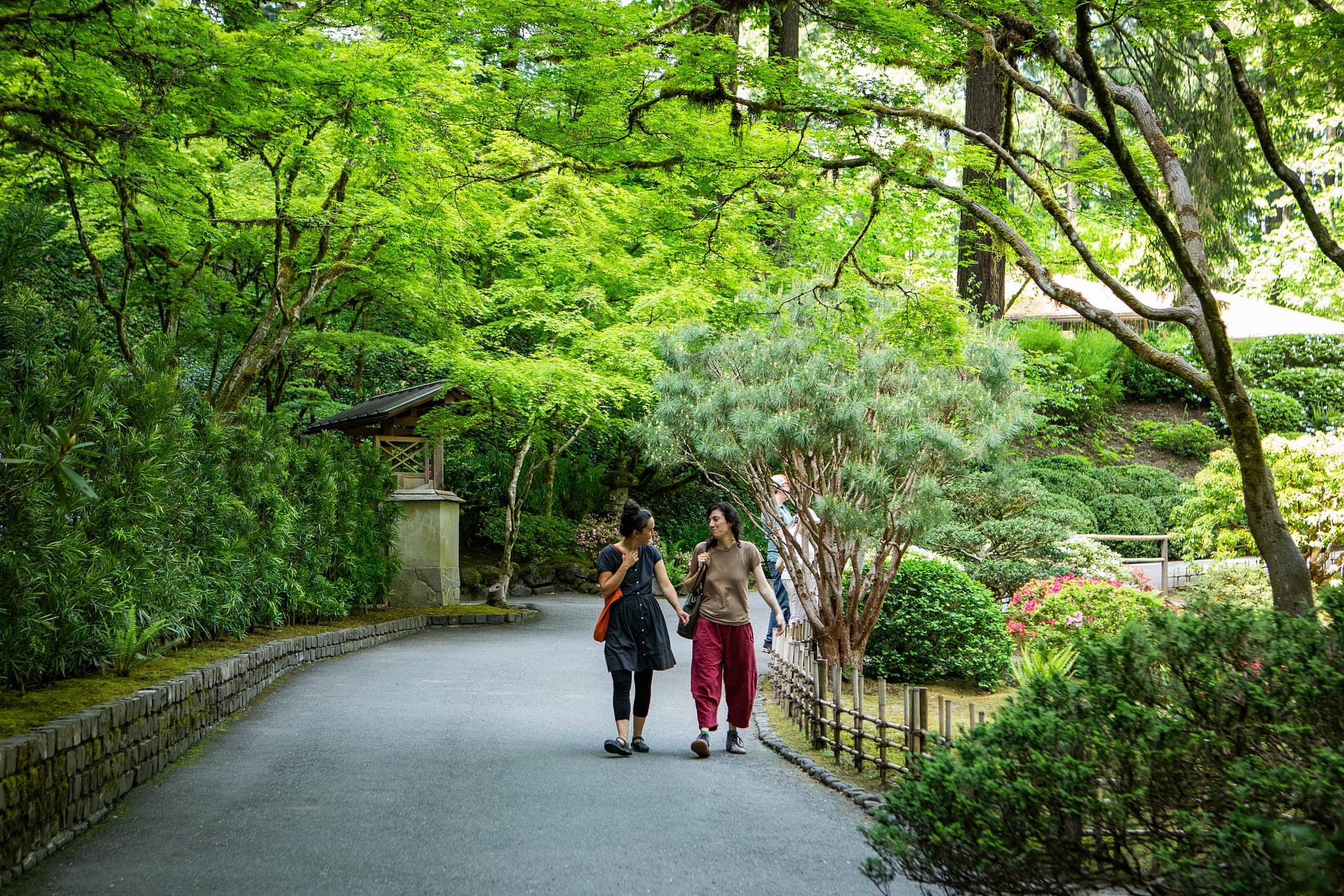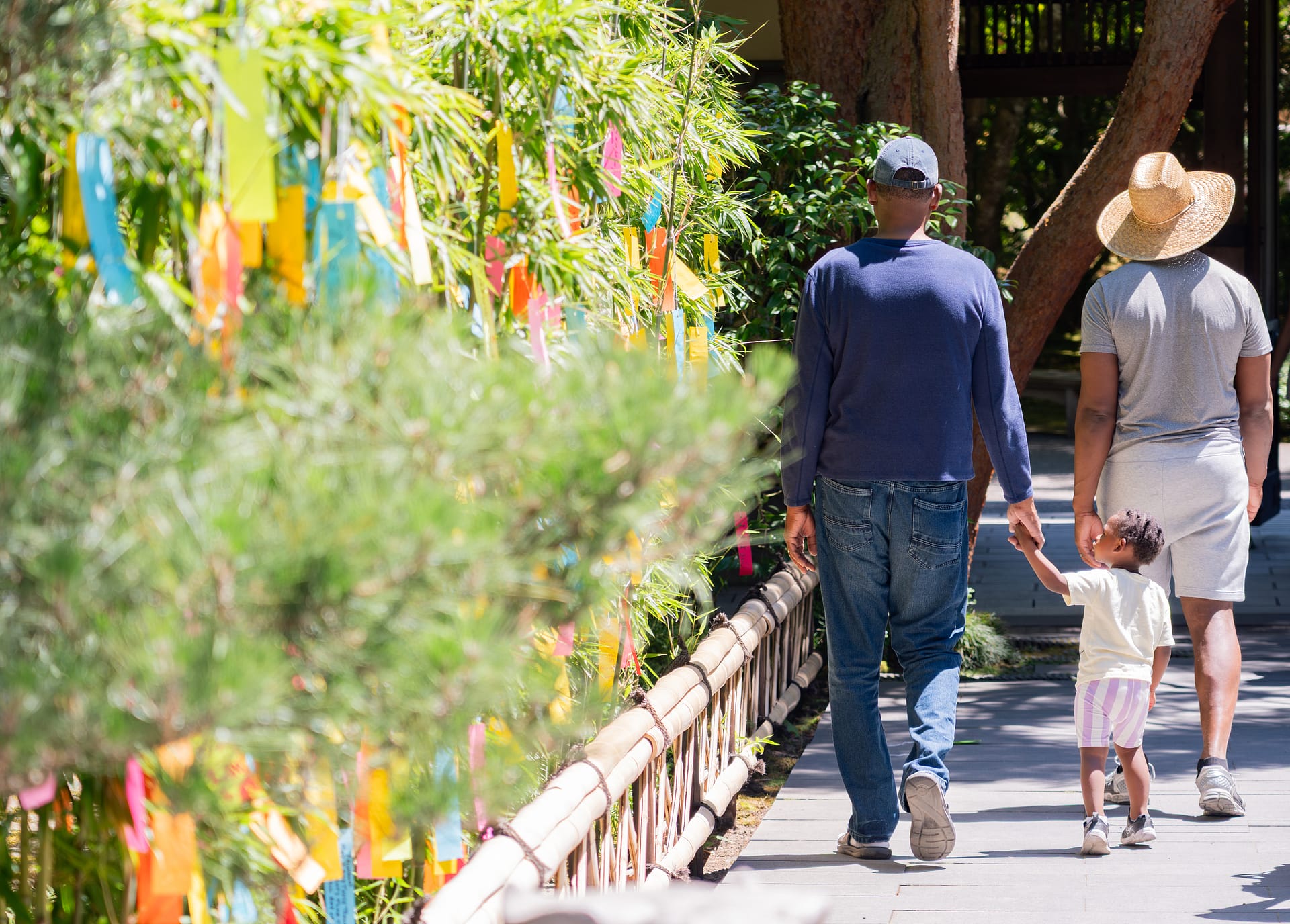
By Will Lerner, Communications Manager for Portland Japanese Garden & Japan Institute
Over four million years ago, someone went for a walk. This would have been unremarkable, save for the possibility that it may have been the first walk on two legs that anyone resembling a human ever took. Ardipithecus ramidus, theorized to be a common ancestor of both humans and apes, began our walking journey with a single step in the forests of what we know today as Ethiopia. Our hominid friends never looked back. The setting for humanity’s story has only recently introduced the urban skyline. For the vast majority of it, the wild was the only home we knew and we traversed it as naturally as we breathe. That’s why walking through a space like Portland Japanese Garden, profoundly articulate in its expression of nature’s beauty, feels so comforting.
However, time in nature has transformed from the only thing we knew to something we schedule. People who spend their time in the Garden know that being outdoors is an experience that should be pursued beyond what we find incidentally in the distance between car and home doors. Research on mindful time in nature, such as shinrin yoku (forest bathing), continually points to its benefits for human health, both physical and mental.
Related: Forest Bathing to Better our Health
Walking provides another means to make us heartier. Recent studies and literature reviews have found that it improves moods, helps prevent cardiovascular disease, reduces hypertension, cholesterol, and obesity, and increases aerobic capacity and joint flexibility. Walking can contribute to improved memory and motor skills and reductions in stress, anxiety, and depression. The evidence has even led some to see it as an anti-aging intervention—though there are some questions to the validity of “Blue Zones,” or areas in which there are higher proportions of significantly older individuals. Some have noted a common trait found in these communities is that their elderly regularly walk and engage in other low-impact physical activity.

Walking has been subject to the whims of wellness trends—some claiming that we must get our 10,000 steps in a day. However, that figure was first arrived at not by physicians or sports scientists, but rather a 1960s advertisement for a Japanese-produced pedometer called the manpo-kei (literally, “10,000 steps meter”). Others have been extolling the virtues of the newly buzzy “Japanese walking” method that alternates fast-paced walking with an easier-going gait.
Related: Take a Strolling Tour of Portland Japanese Garden
While achieving 10,000 steps daily or introducing interval training to your walks may be beneficial, they can also be daunting to include in our routines. So, to help inspire you to achieve some self-care, we’re putting a Portland Japanese Garden twist on a recent New York Times article that introduced some fun and novel ways to get yourself walking. To paraphrase journalist Jancee Dunn, we hope these creative approaches give you some motivation to get out and about in the Garden.
The Sound of Water

There are days in the Garden where the landscape resembles something shaped by a craftsperson’s hands—sunlight gilds firs and cedars, koi shine like jewels, and the breeze has the leaves and limbs of maples in motion like music box dancers. Because of the landscape’s capacity to captivate even regular visitors with beautiful views, the other senses Portland Japanese Garden engages with sometimes get less recognition. And yet it is just as much an aural experience as it is a visual one.
One of the organization’s most beloved stories is that Professor Takuma Tono, the original designer of the Garden, would turn his back to the Heavenly Falls during its construction to concentrate on the sound of the water hitting stones and requested adjustments until the proper notes were achieved.
When walking through the Garden, count all the different sounds of water you encounter—are they rushing like the Heavenly Falls? Gently pouring intermingled with soft hollow strikes of bamboo on stone like the shishi-odoshi (deer chaser) in the Strolling Pond Garden? Echoing like the suikinkutsu (water harp) near the Pavilion? You might be surprised at the variety and nuance you discover.
Following the Transformation of the Seasons




Portland Japanese Garden is not a static thing—it lives and evolves and transforms moment to moment. Sometimes this can be obvious, such as when the cherry blossoms of spring return or the royal colors of autumn hold their court. However, the vast majority of these changes are quiet, subtle, and often unnoticeable. If you can’t be here day-to-day to see the changes slowly unfold, you might consider keeping account with some photography.
With every view carefully considered, the Garden offers a bounty of different vantage points. The best ones are the ones that speak to you. Consider noting a particular angle that captures your attention, minding your relation to the space, and capture photographs from this same spot over time. Look beyond the sky and coloration—what else do you see? Have the gardeners transplanted a new shrub into the space? Have they engaged in some pruning that you can see? Is a young tree joining its older friends in height and diameter?
An especially rewarding way to go about this kind of walk is through a photography membership with the Garden. In addition to the hours all members enjoy, photography members get access to exclusive hours so you can not only capture the landscape with less crowds, but at times when light expresses itself in ways that can be softly enchanting or vigorously dramatic.
Take Count of What You See

Though “Japanese garden” is a malleable term that encompasses a wide-ranging expression of several different design and aesthetic styles, there are nonetheless elements that immediately beckon thoughts of Japan. For example, weathered stone lanterns both tall and squat are undeniably signals of a Japanese landscape. Or perhaps, it’s a subtly rendered structure that blends into the land, like a machiai (sheltered waiting arbor) or bamboo fence. For those with a more horticultural mindset, it might be pruned pines or clouds of azalea.
Related: The Distinction of Japanese Gardens
There are a number of things one can count throughout Portland Japanese Garden. While every landscape is meant to be seen for its overall composition in the same way one listens to an orchestra for how all its musicians interweave and coalesce, focusing on single elements may grant better appreciation for the whole. Throughout all 12.5 acres, pick one thing to count and see how many you can find. It may surprise you to learn how many elements you find—for instance, did you know there are over 25 stone lanterns throughout the grounds of Portland Japanese Garden?
Notice the Colors

Japanese gardens, generally speaking, do not emphasize the same flurry of colors one might encounter in another style, such as the mesmerizing frenzy in Portland’s beloved International Rose Test Garden. Instead, here the grounds are predominantly green. “Japanese gardens do not use a lot of colors and flowers,” noted Michio Wakui, Garden Director of Portland Japanese Garden from 1974 to 1976 in an interview conducted by Ed McVicker, Board President from 2009 to 2011. “For example, when we use camellias, we don’t use many but strategically place it in one spot. English gardens use a lot of colors and have fun with colors. On the other hand, Japanese gardens try to keep it as simple as possible.”
Related: What Makes a Japanese Garden a Japanese Garden?
However, that doesn’t mean that there isn’t nuance and variation among the greens in the Garden. Next time you look across the upper pond of the Strolling Pond Garden, examine the many shades. How many can you see? How do they shift and change when kissed by sunlight or shade? Or, find all the plants that offer something other than green. Spring reigns supreme in the Garden when it comes to flowers, but every season has some kind of bright pop of color. Even winter, when many trees become threadbare, welcomes the graceful camellia.
Or Just Walk

The above are ways to gamify a walk in the Garden, but there is one other way to approach it: Just focus on the walk and the breaths you take.
Thích Nhất Hạnh (1926-2022), a Vietnamese monk who was known as the “father of mindfulness,” wrote in his 2015 book, How to Walk, “We’re in such a rush, looking for happiness in one place and then another. We walk like sleepwalkers, without any enjoyment of what we are actually doing. We are walking, but in our minds we are already doing something else: planning, organizing, worrying. There is no more need to run. Every time we return our attention to our breath and our steps, it’s as if we wake up. Every step brings us back to the here and the now. We can touch the Earth and see the sky and notice all the wonders in between. In each step there is the possibility of mindfulness, concentration, and insight.”
Visit the Garden, walk its paths—you may find some wonders between the Earth and sky.
References
Karolemeas, C., Mitropoulos, L., Koliou, K., Tzamakos, D., Stavropoulou, E., Moschou, E., & Kepaptsoglou, K. (2023). A systematic literature review on health benefits, incentives, and applications to promote walking in urban areas. Future Transportation, 3(4), 1385-1400. https://doi.org/10.3390/futuretransp3040076
Ma, J., Williams, J. M., Morris, P. G., & Chan, S. W. Y. (2023). Effectiveness of a mindful nature walking intervention on sleep quality and mood in university students during covid-19: A randomised control study. Explore (New York, N.Y.), 19(3), 405-416. https://doi.org/10.1016/j.explore.2022.08.004
Nhất Hạnh, T. (2015) How to walk. Parallax Press.
Olcoń, K., Destry, P., Astell-Burt, T., & Allan, J. (2023). “I can get to a happy place by visiting nature”: The benefits of implementing nature walking groups within mental health services. Environmental Advances, 13, 100393. https://doi.org/10.1016/j.envadv.2023.100393
Pymer, S. (2025, June 5). Japanese walking: the benefits of this fitness trend. The Conversation. https://theconversation.com/japanese-walking-the-benefits-of-this-fitness-trend-257302
Schedneck, B. (2022, February 4). What is walking meditation? The Conversation. https://theconversation.com/what-is-walking-meditation-175989
Simek, J. (2021, November 1). When and how was walking invented? The Conversation. https://theconversation.com/when-and-how-was-walking-invented-165516
Smithsonian National Museum of Natural History. (2024, January 3). Ardipithecus ramidus. https://humanorigins.si.edu/evidence/human-fossils/species/ardipithecus-ramidus
Ungvari, Z., Fazekas-Pongor, V., Csiszar, A., & Kunutsor, S. K. (2023). The multifaceted benefits of walking for healthy aging: From blue zones to molecular mechanisms. Geroscience, 45(6), 3211-3239. https://doi.org/10.1007/s11357-023-00873-8
Yates, T.E. (2025, June 15). New research suggests the magic of 10,000 steps a day is a myth. The Independent. https://www.the-independent.com/life-style/health-and-families/walking-10000-steps-a-day-good-health-benefits-b2770397.html
Zimmer, C. (2009, October 1). Ardipithecus: We meet at last. National Geographic. https://www.nationalgeographic.com/science/article/ardipithecus-we-meet-at-last